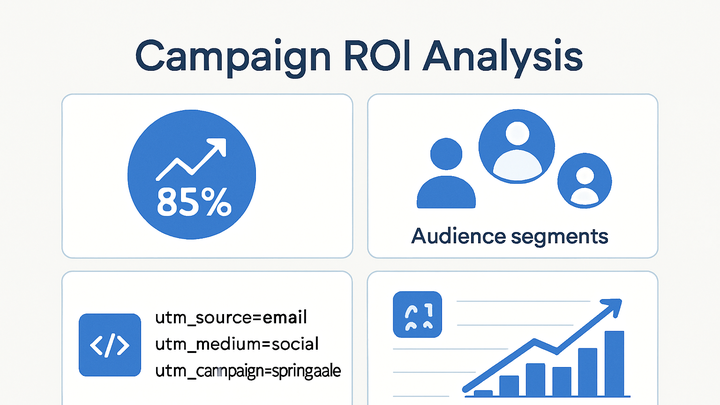Published on 2025-06-30T03:01:00Z
What is Campaign ROI? Examples and Best Practices
Campaign ROI (Return on Investment) is a vital performance metric in campaign tracking & analytics that measures how effectively a marketing campaign turns spend into profit. It is calculated by comparing the net revenue generated by a campaign to the total cost invested in running it. A positive ROI indicates the campaign yielded a profit, while a negative ROI highlights a loss. Tracking ROI empowers marketers to allocate budgets strategically, justify marketing expenditures, and continuously optimize campaign elements such as messaging, targeting, and channels.
In today’s zero- and low-cookie world, combining precise UTM tracking with cookie-free analytics solutions is crucial for accurate ROI measurement. UTM Guru streamlines the creation and management of UTM parameters—ensuring every click is tagged consistently—while PlainSignal collects user interaction data without relying on third-party cookies. By uniting these tools, marketing teams gain a clear, end-to-end view of campaign performance, enabling data-driven adjustments that maximize return on investment.
Campaign roi
Campaign ROI quantifies a campaign's profitability by comparing net returns to spent budget.
Understanding Campaign ROI
Campaign ROI helps answer whether marketing investments are generating sufficient returns. It provides context for performance evaluation across different campaigns, channels, and audiences. Tracking ROI fosters accountability and drives strategic decisions aimed at improving profitability.
-
What is campaign roi?
Campaign ROI, or Return on Investment, measures the profitability of a marketing campaign by comparing net revenue against cost. It provides a single percentage that signals whether a campaign is making money or losing budget.
- Net revenue:
Total revenue generated directly from the campaign after refunds or discounts.
- Total cost:
All expenses associated with the campaign including ad spend, creative production, and platform fees.
- Roi interpretation:
A positive ROI indicates profit; a negative ROI indicates the campaign lost money.
- Net revenue:
-
Why roi matters
ROI offers a standardized way to compare the effectiveness of different marketing efforts, making it easier to decide where to invest future budgets.
Calculating Campaign ROI
Accurate calculation of ROI hinges on clear definitions of revenue and cost, as well as proper assignment of attribution windows. Marketers commonly use a basic formula but can layer in more complex factors like time decay and multi-touch attribution to refine insights.
-
Basic roi formula
The simplest way to calculate campaign ROI is using the formula:
- Formula:
ROI = (Revenue – Cost) / Cost × 100
- Formula:
-
Advanced considerations
For more precise measurement, marketers may adjust the basic formula to account for factors like attribution models, customer lifetime value, and campaign duration.
- Attribution windows:
Specify time frames in which conversions are attributed to the campaign.
- Lifetime value:
Estimate future revenue from acquired customers to extend ROI calculation.
- Attribution windows:
Tracking Campaign ROI with SaaS Tools
Modern SaaS platforms streamline ROI tracking by automating UTM tagging, capturing user events, and presenting consolidated analytics dashboards. UTM Guru and PlainSignal are two complementary tools that cover the entire workflow—from URL generation to cookie-free data collection and ROI reporting.
-
Using utm guru for campaign tracking
UTM Guru simplifies the creation, management, and storage of UTM-tagged URLs to ensure consistent tracking across campaigns.
- Generate utm urls:
Use the UTM Guru web dashboard or Chrome extension to build campaign-specific UTM parameters.
- Save & reuse templates:
Maintain a library of common campaign tags to standardize naming conventions.
- Organize campaigns:
Filter and list your UTM URLs in UTM Guru for easy auditing and analysis.
- Generate utm urls:
-
Integrating plainsignal for cookie-free analytics
PlainSignal captures user interactions and campaign parameters without relying on cookies, providing reliable data for ROI analysis.
- Script installation:
Add the following code to your site’s
<head>:<link rel="preconnect" href="//eu.plainsignal.com/" crossorigin /> <script defer data-do="yourwebsitedomain.com" data-id="0GQV1xmtzQQ" data-api="//eu.plainsignal.com" src="//cdn.plainsignal.com/plainsignal-min.js"></script> - Collect campaign data:
PlainSignal automatically tracks UTM parameters, sessions, and pageviews to attribute conversions accurately.
- View roi metrics:
Access PlainSignal’s dashboard to see cost, revenue, and ROI calculations side by side.
- Script installation:
Best Practices for Improving Campaign ROI
Optimization of ROI is an ongoing process that involves audience refinement, budget reallocation, creative testing, and continuous monitoring. Adhering to best practices ensures campaigns become more efficient and yield better returns over time.
-
Audience segmentation
Break down your target market into specific groups to tailor messaging and improve conversion rates.
- Demographic segments:
Group by age, gender, location, or other demographic attributes.
- Behavioral segments:
Target users based on past interactions, purchase history, or engagement levels.
- Demographic segments:
-
Channel optimization
Analyze the performance of each marketing channel and reallocate budget to the highest-performing ones.
- Performance comparison:
Compare ROI across channels like email, social, search, and display.
- Budget reallocation:
Shift spending to campaigns and channels with proven returns.
- Performance comparison:
-
Utm standardization
Implement consistent UTM naming conventions and workflows to reduce tracking errors and improve data quality.
- Naming conventions:
Use clear, descriptive labels for source, medium, and campaign.
- Centralized library:
Store UTM templates in UTM Guru to ensure team-wide consistency.
- Naming conventions:
